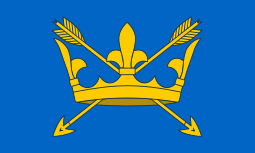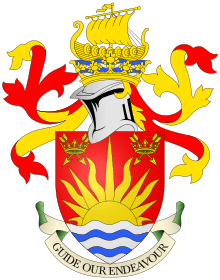Suffolk
Suffolk (/ˈsʌfək/) is an East Anglian county of historic origin in England. It has borders with Norfolk to the north, Cambridgeshire to the west and Essex to the south. The North Sea lies to the east. The county town is Ipswich; other important towns include Lowestoft, Bury St Edmunds, Newmarket, and Felixstowe, one of the largest container ports in Europe.[2]
| Suffolk | |||||
|---|---|---|---|---|---|
| Ceremonial county | |||||
| |||||
| Motto: "Guide Our Endeavour" | |||||
 | |||||
| Coordinates: 52°10′N 1°00′E | |||||
| Sovereign state | United Kingdom | ||||
| Constituent country | England | ||||
| Region | East | ||||
| Established | Ancient | ||||
| Ceremonial county | |||||
| Lord Lieutenant | Clare FitzRoy, Countess of Euston | ||||
| High Sheriff | Bridget McIntyre[1] (2020–21) | ||||
| Area | 3,798 km2 (1,466 sq mi) | ||||
| • Ranked | 8th of 48 | ||||
| Population (mid-2019 est.) | 758,556 | ||||
| • Ranked | 32nd of 48 | ||||
| Density | 200/km2 (520/sq mi) | ||||
| Ethnicity | 97.2% White | ||||
| Non-metropolitan county | |||||
| County council | Suffolk County Council | ||||
| Executive | Conservative | ||||
| Admin HQ | Ipswich | ||||
| Area | 4,106 km2 (1,585 sq mi) | ||||
| • Ranked | 6th of 26 | ||||
| Population | 761350 | ||||
| • Ranked | 13th of 26 | ||||
| Density | 200/km2 (520/sq mi) | ||||
| ISO 3166-2 | GB-SFK | ||||
| ONS code | 42 | ||||
| GSS code | E10000029 | ||||
| NUTS | UKH14 | ||||
| Website | www | ||||
 Districts of Suffolk | |||||
| Districts |
| ||||
| Members of Parliament | List of MPs | ||||
| Police | Suffolk Constabulary | ||||
| Time zone | Greenwich Mean Time (UTC) | ||||
| • Summer (DST) | British Summer Time (UTC+1) | ||||
The county is low-lying but it has quite a few hills (especially more to the west), and has largely arable land with the wetlands of the Broads in the north. The Suffolk Coast and Heaths are an Area of Outstanding Natural Beauty.
History
Administration
The Anglo-Saxon settlement Suffolk, and East Anglia generally, occurred on a large scale,[3] possibly following a period of depopulation by the previous inhabitants, the Romanized descendants of the Iceni.[4] By the fifth century, they had established control of the region. The Anglo-Saxon inhabitants later became the "north folk" and the "south folk", from which developed the names "Norfolk" and "Suffolk".[5] Suffolk and several adjacent areas became the kingdom of East Anglia, which later merged with Mercia and then Wessex.
Suffolk was originally divided into four separate Quarter Sessions divisions. In 1860, the number of divisions was reduced to two. The eastern division was administered from Ipswich and the western from Bury St Edmunds. Under the Local Government Act 1888, the two divisions were made the separate administrative counties of East Suffolk and West Suffolk;[6] Ipswich became a county borough. A few Essex parishes were also added to Suffolk: Ballingdon-with-Brundon and parts of Haverhill and Kedington.
On 1 April 1974, under the Local Government Act 1972, East Suffolk, West Suffolk, and Ipswich were merged to form the unified county of Suffolk. The county was divided into several local government districts: Babergh, Forest Heath, Ipswich, Mid Suffolk, St Edmundsbury, Suffolk Coastal, and Waveney. This act also transferred some land near Great Yarmouth to Norfolk. As introduced in Parliament, the Local Government Act would have transferred Newmarket and Haverhill to Cambridgeshire and Colchester from Essex; such changes were not included when the act was passed into law.[7]
In 2007, the Department for Communities and Local Government referred Ipswich Borough Council's bid to become a new unitary authority to the Boundary Committee.[8] The Boundary Committee consulted local bodies and reported in favour of the proposal. It was not, however, approved by the Secretary of State for Communities and Local Government.
Beginning in February 2008, the Boundary Committee again reviewed local government in the county, with two possible options emerging. One was that of splitting Suffolk into two unitary authorities – Ipswich and Felixstowe and Rural Suffolk; and the other, that of creating a single county-wide controlling authority – the "One Suffolk" option.[9] In February 2010, the then-Minister Rosie Winterton announced that no changes would be imposed on the structure of local government in the county as a result of the review, but that the government would be: "asking Suffolk councils and MPs to reach a consensus on what unitary solution they want through a countywide constitutional convention".[10] Following the May 2010 general election, all further moves towards any of the suggested unitary solutions ceased on the instructions of the incoming Coalition government.[11] In 2018 it was determined that Forest Heath and St Edmundsbury would be merged to form a new West Suffolk district,[12] while Waveney and Suffolk Coastal would similarly form a new East Suffolk district.[13] These changes took effect on 1 April 2019.
Archaeology
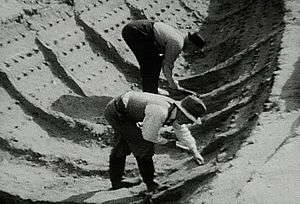
West Suffolk, like nearby East Cambridgeshire, is renowned for archaeological finds from the Stone Age, the Bronze Age, and the Iron Age. Bronze Age artefacts have been found in the area between Mildenhall and West Row, in Eriswell and in Lakenheath.[14] Many bronze objects, such as swords, spearheads, arrows, axes, palstaves, knives, daggers, rapiers, armour, decorative equipment (in particular for horses), and fragments of sheet bronze, are entrusted to St. Edmundsbury heritage service, housed at West Stow just outside Bury St. Edmunds. Other finds include traces of cremations and barrows.
In the east of the county is Sutton Hoo, the site of one of England's most significant Anglo-Saxon archaeological finds, a ship burial containing a collection of treasures including a Sword of State, gold and silver bowls, and jewellery and a lyre.[15]
Geography

Located in the East of England,[16] much of Suffolk is low-lying, founded on Pleistocene sand and clays. These rocks are relatively unresistant and the coast is eroding rapidly. Coastal defences have been used to protect several towns, but several cliff-top houses have been lost to coastal erosion and others are under threat. The continuing protection of the coastline and the estuaries, including the Blyth, Alde and Deben, has been, and remains, a matter of considerable discussion.[17]
The coastal strip to the East contains an area of heathland known as "The Sandlings" which runs almost the full length of the coastline.[18] Suffolk is also home to nature reserves, such as the RSPB site at Minsmere, and Trimley Marshes, a wetland under the protection of Suffolk Wildlife Trust. The clay plateau inland, deeply intercut by rivers, is often referred to as 'High Suffolk'.
The west of the county lies on more resistant Cretaceous chalk. This chalk is responsible for a sweeping tract of largely downland landscapes that stretches from Dorset in the south west to Dover in the south east and north through East Anglia to the Yorkshire Wolds. The chalk is less easily eroded so forms the only significant hills in the county. The highest point in the county is Great Wood Hill, the highest point of the Newmarket Ridge, near the village of Rede, which reaches 128 metres (420 ft).
Demography
According to estimates by the Office for National Statistics, the population of Suffolk in 2014 was 738,512, split almost evenly between males and females. Roughly 22% of the population was aged 65 or older, and 90.84% were "White British".[20]
Historically, the county's population has mostly been employed as agricultural workers. An 1835 survey showed Suffolk to have 4,526 occupiers of land employing labourers, 1,121 occupiers not employing labourers, 33,040 labourers employed in agriculture, 676 employed in manufacture, 18,167 employed in retail trade or handicraft, 2,228 'capitalists, bankers etc.', 5,336 labourers (non-agricultural), 4,940 other males aged over 20, 2,032 male servants and 11,483 female servants.[21] The same publication records the total population of the county at 296,304.
Most English counties have nicknames for people from that county, such as a Tyke from Yorkshire and a Yellowbelly from Lincolnshire. A traditional nicknames for people from Suffolk is 'Suffolk Fair-Maids' referring to the supposed beauty of its female inhabitants in the Middle Ages.[22] Another is 'Silly Suffolk', derived from the Old English word sælig meaning blessed referring to the long history of Christianity in the county, its many fine churches, and the influential Bury Abbey.[23] Use of the term ‘Silly Suffolk’ can be dated to 1819 with its origins probably being older.[24]
There are several towns in the county with Ipswich being the largest and most populous. At the time of the 2011 census, a population of 730,000 lived in the county with 133,384 living in Ipswich. The table below shows all towns with over 20,000 inhabitants.
| Rank | Town | Population | Borough/District council |
|---|---|---|---|
| 1 | Ipswich | 133,384 (2011) | Ipswich Borough Council |
| 2 | Lowestoft | 71,000 (2011) | East Suffolk Council |
| 3 | Bury St Edmunds | 42,000 (2011) | West Suffolk Council |
| 4 | Haverhill | 27,041 (2011) | West Suffolk Council |
| 5 | Felixstowe | 23,689 (2011) | East Suffolk Council |
| 6 | Newmarket | 20,384 (2011) | West Suffolk Council |
Economy

The majority of agriculture in Suffolk is either arable or mixed. Farm sizes vary from anything around 80 acres (32 hectares) to over 8,000. Soil types vary from heavy clays to light sands. Crops grown include winter wheat, winter barley, sugar beet, oilseed rape, winter and spring beans and linseed, although smaller areas of rye and oats can be found growing in areas with lighter soils along with a variety of vegetables.
The continuing importance of agriculture in the county is reflected in the Suffolk Show, which is held annually in May at Ipswich. Although latterly somewhat changed in nature, this remains primarily an agricultural show.[25]
Well-known companies in Suffolk include Greene King and Branston Pickle in Bury St Edmunds. Birds Eye has its largest UK factory in Lowestoft, where all its meat products and frozen vegetables are processed. Huntley & Palmers biscuit company has a base in Sudbury. The UK horse racing industry is based in Newmarket. There are two USAF bases in the west of the county close to the A11. Sizewell B nuclear power station is at Sizewell on the coast near Leiston. Bernard Matthews Farms have some processing units in the county, specifically Holton. Southwold is the home of Adnams Brewery. The Port of Felixstowe is the largest container port in the United Kingdom. Other ports are at Lowestoft and Ipswich, run by Associated British Ports. BT has its main research and development facility at Martlesham Heath.
Below is a chart of regional gross value added of Suffolk at current basic prices published by Office for National Statistics with figures in millions of British Pounds Sterling.
| Year | Regional gross value added[fn 1] | Agriculture[fn 2] | Industry[fn 3] | Services[fn 4] |
|---|---|---|---|---|
| 1995 | 7,113 | 391 | 2,449 | 4,273 |
| 2000 | 8,096 | 259 | 2,589 | 5,248 |
| 2003 | 9,456 | 270 | 2,602 | 6,583 |
| Source[26] | ||||
Education
Primary, secondary and further education
Suffolk has a comprehensive education system with fourteen independent schools. Unusually for the UK, some of Suffolk had a 3-tier school system in place with primary schools (ages 5–9), middle schools (ages 9–13) and upper schools (ages 13–16). However, a 2006 Suffolk County Council study concluded that Suffolk should move to the 2-tier school system used in the majority of the UK.[27] For the purpose of conversion to 2-tier, the 3-tier system was divided into 4 geographical area groupings and corresponding phases. The first phase was the conversion of schools in Lowestoft and Haverhill in 2011, followed by schools in north and west Suffolk in 2012. The remainder of the changeovers to 2-tier took place from 2013, for those schools that stayed within Local government control, and did not become Academies and/or free schools. The majority of schools thus now (2019) operate the more common primary to high school (11–16).
Many of the county's upper schools have a sixth form and most further education colleges in the county offer A-level courses. In terms of school population, Suffolk's individual schools are large with the Ipswich district with the largest school population and Forest Heath the smallest, with just two schools. In 2013, a letter said that "...nearly a fifth of the schools inspected were judged inadequate. This is unacceptable and now means that Suffolk has a higher proportion of pupils educated in inadequate schools than both the regional and national averages."[28]
The Royal Hospital School near Ipswich is the largest independent boarding school in Suffolk. Other boarding schools within Suffolk include Barnardiston Hall Preparatory School, Culford School, Finborough School, Framlingham College, Ipswich High School, Ipswich School, Saint Felix School and Woodbridge School.
The Castle Partnership Academy Trust in Haverhill is the county's only All-through Academy Chain. Comprising Castle Manor Academy and Place Farm Primary Academy, the Academy Trust supports all-through education and provides opportunities for young people aged 3 to 18.
Sixth form colleges in the county include Lowestoft Sixth Form College and One in Ipswich. Suffolk is home to four further education colleges: Lowestoft College, Easton & Otley College, Suffolk New College (Ipswich) and West Suffolk College (Bury St Edmunds).
Tertiary education
The county has one university, with branches spread across different towns. University of Suffolk was, prior to August 2016, known as University Campus Suffolk. Up until it became independent it was a collaboration between the University of Essex and the University of East Anglia which sponsored its formation and validated its degrees.[29][30] UOS accepted its first students in September 2007. Until then Suffolk was one of only four counties in England which did not have a University campus.[29] The University of Suffolk was granted Taught Degree Awarding Powers by the Quality Assurance Agency for Higher Education in November 2015, and in May 2016 it was awarded University status by the Privy Council and renamed The University of Suffolk on 1 August 2016.[31][32]
The University operates at five sites with its central hub in Ipswich. Others include Lowestoft, Bury St. Edmunds, and Great Yarmouth in Norfolk.[33] The University operates two academic faculties and in 2018/19 had 7,695 students. Some 30% of the student body are classed as mature students and 68% of University students are female.[34]
Culture
Arts

Founded in 1948 by Benjamin Britten, the annual Aldeburgh Festival is one of the UK's major classical music festivals. Originating in Aldeburgh, it has been held at the nearby Snape Maltings since 1967.[35] Since 2006, Henham Park, has been home to the annual Latitude Festival. This mainly open-air festival, which has grown considerably in size and scope, includes popular music, comedy, poetry and literary events. The FolkEast festival is held at Glemham Hall in August[36] and attracts international acoustic, folk and roots musicians whilst also championing local businesses, heritage and crafts. In 2015 it was also home to the first instrumental festival of musical instruments and makers.[37] More recently, LeeStock Music Festival has been held in Sudbury.[38] A celebration of the county, "Suffolk Day", was instigated in 2017.[39]
Dialect
The Suffolk dialect is very distinctive. Epenthesis and yod-dropping is common, along with non-conjugation of verbs.[40]
Sport
Football
The county's sole professional football club is Ipswich Town. Formed in 1878, the club were Football League champions in 1961–62, FA Cup winners in 1977–78 and UEFA Cup winners in 1980–81.[41] Ipswich Town currently play in League One, the third tier of English football. The next highest ranked teams in Suffolk are Leiston, Lowestoft Town and Needham Market, who all participate in the Southern League Premier Division Central, the seventh tier of English football.
Horse racing
The town of Newmarket is the headquarters of British horseracing – home to the largest cluster of training yards in the country and many key horse racing organisations including the National Stud,[42] and Newmarket Racecourse. Tattersalls bloodstock auctioneers and the National Horseracing Museum are also in the town.[43][44] Point to point racing takes place at Higham and Ampton.[45]
Speedway
Speedway racing has been staged in Suffolk since at least the 1950s, following the construction of the Foxhall Stadium, just outside Ipswich, home of the Ipswich Witches. The Witches are currently members of the Premier League, the UK's first division.[46] National League team Mildenhall Fen Tigers are also from Suffolk.[47]
Cricket
Suffolk C.C.C. compete in the Eastern Division of the Minor Counties Championship.[48] The club has won the championship three times outright and has shared the title one other time as well as winning the MCCA Knockout Trophy once.[49] Home games are played in Bury St Edmunds, Copdock, Exning, Framlingham, Ipswich and Mildenhall.[50]
Suffolk in popular culture
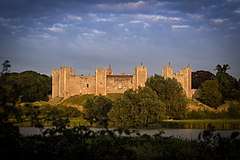
Novels set in Suffolk include parts of David Copperfield by Charles Dickens, The Fourth Protocol, by Frederick Forsyth, Unnatural Causes by P.D. James, Dodie Smith's The Hundred and One Dalmatians, The Rings of Saturn by W. G. Sebald,[51] and among Arthur Ransome's children's books, We Didn't Mean to Go to Sea, Coot Club and Secret Water take place in part in the county. Roald Dahl's short story "The Mildenhall Treasure" is set in Mildenhall.[52]
A TV series about a British antiques dealer, Lovejoy, was filmed in various locations in Suffolk.[53] The reality TV series Space Cadets was filmed in Rendlesham Forest, although the producers fooled participants into believing that they were in Russia.[54] Several towns and villages in the county have been used for location filming of other television programmes and cinema films. These include the BBC Four TV series Detectorists,[55] an episode of Kavanagh QC, and the films Iris and Drowning by Numbers. During 2017 and 2018, a total of £3.8million was spent by film crews in. Suffolk[56]
The Rendlesham Forest Incident is one of the most famous UFO events in England and is sometimes referred to as "Britain's Roswell".[57]
The song "Castle on the Hill" by singer-songwriter Ed Sheeran was referred to by him as "a love letter to Suffolk", with lyrical reference to his hometown of Framlingham and Framlingham Castle.[58][59]
Notable people

In the arts, Suffolk is noted for having been the home to two of England's best regarded painters, Thomas Gainsborough[60] and John Constable – the Stour Valley area is branded as "Constable Country"[61] – and one of its most noted composers, Benjamin Britten.[62] Other artists of note from Suffolk include sculptress Dame Elizabeth Frink, the cartoonist Carl Giles (a bronze statue of his character "Grandma" to commemorate this is located in Ipswich town centre), poets George Crabbe[63] and Robert Bloomfield,[64] writer and Literary editor Ronald Blythe, actors Ralph Fiennes[65] and Bob Hoskins, actress and singer Kerry Ellis, musician and record producer Brian Eno,[66] singer Dani Filth, of the Suffolk-based extreme metal group, Cradle of Filth, singer-songwriter Ed Sheeran, and coloratura soprano Christina Johnston.
Hip-hop DJ Tim Westwood is originally from Suffolk and the influential DJ and radio presenter John Peel made the county his home.[67] Contemporary painter, Maggi Hambling, was born, and resides, in Suffolk. Norah Lofts, author of best-selling historical novels, lived for decades in Bury St. Edmunds where she died and was buried in 1983. Sir Peter Hall the founder of the Royal Shakespeare Company was born in Bury St. Edmunds, and Sir Trevor Nunn the theatre director was born in Ipswich.
Suffolk's contributions to sport include Formula One magnate Bernie Ecclestone and former England footballers Terry Butcher, Kieron Dyer and Matthew Upson. Due to Newmarket being the centre of British horse racing many jockeys have settled in the county, including Lester Piggott and Frankie Dettori.
Significant ecclesiastical figures from Suffolk include Simon Sudbury, a former Archbishop of Canterbury;[68] Tudor-era Catholic prelate Thomas, Cardinal Wolsey;[69] and author, poet and Benedictine monk John Lydgate.[70] Edward FitzGerald, the first translator of The Rubaiyat of Omar Khayyam, was born in Bredfield.
Other significant persons from Suffolk include the suffragette Dame Millicent Garrett Fawcett;[71] the captain of HMS Beagle, Robert FitzRoy;[72] Witch-finder General Matthew Hopkins;[73] educationist Hugh Catchpole;[74][75] and Britain's first female physician and mayor, Elizabeth Garrett Anderson.[76] Charity leader Sue Ryder settled in Suffolk and based her charity in Cavendish.
Edmund of East Anglia
King of East Anglia and Christian martyr St Edmund (after whom the town of Bury St Edmunds is named) was killed by invading Danes in the year 869. St Edmund was the patron saint of England until he was replaced by St George in the 13th century. 2006 saw the failure of a campaign to have St Edmund named as the patron saint of England, but in 2007 he was named patron saint of Suffolk, with St Edmund's Day falling on 20 November. His flag is flown in Suffolk on that day.
Gallery
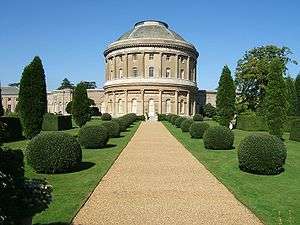 Ickworth House close to Bury St Edmunds
Ickworth House close to Bury St Edmunds Southwold, a popular seaside town
Southwold, a popular seaside town.jpg) Lavenham is a preserved medieval village
Lavenham is a preserved medieval village
 Bank of the River Orwell
Bank of the River Orwell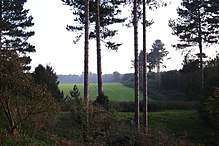
 Ipswich Waterfront, once the most important dock in the kingdom
Ipswich Waterfront, once the most important dock in the kingdom Aldeburgh beachfront
Aldeburgh beachfront Ancient Cottages in Kersey
Ancient Cottages in Kersey_and_the_lighthouse_-_geograph.org.uk_-_261134.jpg) Lighthouse at Orford Ness, a national trust site
Lighthouse at Orford Ness, a national trust site
See also
- Custos Rotulorum of Suffolk – Keepers of the Rolls
- Healthcare in Suffolk
- List of High Sheriffs of Suffolk
- List of Lords Lieutenant of Suffolk
- List of places of interest in Suffolk
- Suffolk (UK Parliament constituency) – Historical list of MPs for Suffolk constituency
- Suffolk Police and Crime Commissioner
- Suffolk Youth Orchestra
Notes
- Components may not sum to totals due to rounding
- includes hunting and forestry
- includes energy and construction
- includes financial intermediation services indirectly measured
References
- "No. 62943". The London Gazette. 13 March 2020. p. 5161.
- "Top 50 Container Ports in Europe". World Shipping Council. Archived from the original on 27 August 2013. Retrieved 17 July 2015.
- Toby F. Martin, The Cruciform Brooch and Anglo-Saxon England, Boydell and Brewer Press (2015), pp. 174-178
- Dark, Ken R. "Large-scale population movements into and from Britain south of Hadrian's Wall in the fourth to sixth centuries AD" (PDF).
- "English Place Names". englishplaceneames.co.uk. James Rye. Archived from the original on 31 December 2009. Retrieved 20 October 2015.
- "Local Government Act, 1888" (PDF). Government of the United Kingdom. Archived (PDF) from the original on 3 December 2015. Retrieved 21 October 2015.
- "Local Government Act 1972". Government of the United Kingdom. Archived from the original on 16 October 2015. Retrieved 21 October 2015.
- "[ARCHIVED CONTENT] UK Government Web Archive". Government of the United Kingdom. Archived from the original on 19 September 2012.
- "Suffolk structural review". The Electoral Commission. Archived from the original on 9 May 2009. Retrieved 21 September 2009.
- "Unitary authorities-Exeter and Norwich get green light; Suffolk to decide locally; no change for Norfolk and Devon". Department for Communities and Local Government. Archived from the original on 14 February 2010. Retrieved 10 February 2010.
- "Pickles stops unitary councils in Exeter, Norwich and Suffolk". Department for Communities and Local Government. Archived from the original on 30 May 2010. Retrieved 25 July 2010.
- Ministry of Housing, Communities and Local Government (24 May 2018). "The West Suffolk (Local Government Changes) Order 2018". Government of the United Kingdom. Archived from the original on 29 May 2018. Retrieved 28 May 2018.
- Ministry of Housing, Communities and Local Government (24 May 2018). "The East Suffolk (Local Government Changes) Order 2018". Government of the United Kingdom. Archived from the original on 28 May 2018. Retrieved 28 May 2018.
- Hall, David (1994). Fenland survey : an essay in landscape and persistence / David Hall and John Coles. London; English Heritage. ISBN 1-85074-477-7., p. 81-88
- "Sutton Hoo History". nationaltrust.org. The National Trust. Archived from the original on 11 October 2015. Retrieved 22 October 2015.
- Archived 7 April 2008 at the Wayback Machine
- Archived 25 September 2009 at the Wayback Machine
- Archived 18 October 2012 at the Wayback Machine
- "Oxlip | Plant & fungi species | Wild plants". Plantlife.org.uk. Archived from the original on 25 June 2015. Retrieved 6 June 2015.
- "Area Profile Suffolk Observatory". suffolkobservatory.info. GeoWise. Archived from the original on 17 March 2016. Retrieved 21 October 2015.
- 'The British Almanac' – 1835
- Nall, John Greaves (2006). Nall's Glossary of East Anglian Dialect. Larks Press. ISBN 978-1-904006-34-3.
- Torlesse, Charles Martin (1877). Some Account of Stoke by Nayland, Suffolk ... Harrison.
- Plowman, William (1819). Concise remarks on game mania, by Flagellus.
- "The Suffolk Show". suffolkshow.co.uk. Suffolk Show 2015. Archived from the original on 12 November 2015. Retrieved 20 October 2015.
- "[ARCHIVED CONTENT] UK Government Web Archive" (PDF). Government of the United Kingdom. Archived from the original (PDF) on 26 February 2007.
- "Suffolk Free Press". Sudburytoday.co.uk. Retrieved 6 June 2015.
- "Letter to local authority DCS following focused school inspections" (PDF). Archived (PDF) from the original on 5 March 2016. Retrieved 29 February 2016.
- University Campus Suffolk Archived 26 January 2013 at the Wayback Machine, University of Essex. Retrieved 28 September 2012.
- University Campus Suffolk guide Archived 27 June 2012 at the Wayback Machine, Daily Telegraph, 21 June 2011. Retrieved 28 September 2012.
- "University Campus Suffolk gains independence". BBC News. 17 May 2016. Archived from the original on 1 December 2017. Retrieved 21 June 2018.
- "University Campus Suffolk gains approval to become the University of Suffolk". ucs.ac.uk. 4 July 2016. Archived from the original on 21 May 2016. Retrieved 18 May 2016.
- University Campus Suffolk Archived 7 July 2015 at the Wayback Machine, University of East Anglia. Retrieved 28 September 2012.
- "University of Suffolk". university.which.co.uk. Archived from the original on 27 September 2016. Retrieved 10 February 2017.
- "Aldeburgh Festival History". aldeburgh.co.uk. Aldeburgh Music. Archived from the original on 20 September 2015. Retrieved 21 October 2015.
- "Festivals guide 2014 listings: folk and world music". The Guardian. 31 May 2014. Archived from the original on 21 September 2016. Retrieved 16 December 2016.
- "Instrumental at Folk East". folkeast.co.uk. FolkEast Ltd. Archived from the original on 16 October 2015. Retrieved 21 October 2015.
- "LeeStock Music Festival". leestock.org. Leestock Musical Festival Ltd. Archived from the original on 10 December 2015. Retrieved 21 October 2015.
- "Why we should celebrate our county with Suffolk Day". East Anglian Daily Times. 31 March 2017. Archived from the original on 31 March 2017. Retrieved 1 April 2017.
- Claxton, A. O. D. (1954). The Suffolk Dialect of the Twentieth Century (First ed.). Ipswich, Suffolk: The Boydell Press Ltd. ISBN 0-85115-026-8.
- "Club honours". Ipswich Town F.C. Archived from the original on 13 December 2005. Retrieved 14 April 2008.
- "Suffolk Tourism". suffolktouristguide.com. Archived from the original on 29 January 2009. Retrieved 2 February 2009.
- "Tattersalls". tattersalls.com. Tattersalls Ltd. Archived from the original on 26 October 2015. Retrieved 21 October 2015.
- "National Horseracing Museum". National Horseracing Museum. Retrieved 21 October 2015.
- "Courses". pointingea.com. Archived from the original on 8 May 2008. Retrieved 14 April 2008.
- "Ipswich Speedway Official Website". ipswichwitches.co. Ipswich Speedway. Archived from the original on 1 January 2016. Retrieved 21 October 2015.
- "Mildenhall Fen Tigers". mildenhallfentigers.co. Mildenhall Speedway. Archived from the original on 1 January 2016. Retrieved 21 October 2015.
- "Minor Counties Cricket Association". ESPNcricinfo. Archived from the original on 23 August 2008. Retrieved 27 August 2008.
- "Minor Counties Roll of Honour". ecb.co.uk. Archived from the original on 11 September 2011. Retrieved 27 August 2008.
- "Minor County Grounds". ESPNcricinfo. Archived from the original on 24 July 2008. Retrieved 27 August 2008.
- "The Rings of Saturn". The New York Times. Archived from the original on 9 December 2015. Retrieved 8 December 2015.
- "Roald Dahl and the Mildenhall Treasure". British Museum. Archived from the original on 2 April 2012. Retrieved 21 October 2015.
- "Lovejoy". IMDb. 10 January 1986. Archived from the original on 21 August 2016. Retrieved 30 June 2018.
- "Space Cadets". ukgameshows.com. UK Game Shows. Archived from the original on 1 November 2015. Retrieved 21 October 2015.
- Season 1, DVD extra 'Behind-the-Scenes'
- "David Copperfield film shoot in Bury St Edmunds generated £82,500 for town's economy". Bury Free Press. 1 March 2019. Archived from the original on 2 March 2019. Retrieved 18 March 2019.
- "UFOFiles Rendlesham Forest". The Daily Telegraph. Archived from the original on 26 October 2015. Retrieved 21 October 2015.
- "Castle on the Hill: Ed Sheeran's love letter to Suffolk, Ed Sheeran co-host..., Scott Mills – BBC Radio 1". BBC. Archived from the original on 8 January 2017. Retrieved 23 January 2017.
- "Ed Sheeran". Contactmusic.com. Archived from the original on 24 January 2017. Retrieved 24 January 2017.
- "Biography". Gainsborough's House. Archived from the original on 9 May 2008. Retrieved 30 October 2008.
- "Constable Country walk". The National Trust. Archived from the original on 26 September 2008. Retrieved 30 October 2008.
- "Interviews: Benjamin Britten 1913 – 1976". BBC Four online. Archived from the original on 28 January 2007. Retrieved 30 October 2008.
- "George Crabbe | English poet". Encyclopedia Britannica. Archived from the original on 23 June 2018. Retrieved 15 March 2018.
- Cousin, John W. "A Short Biographical Dictionary of English Literature". Project Gutenberg. Archived from the original on 4 September 2015. Retrieved 30 October 2008.
- "Ralph Fiennes | Biography & Credits". Encyclopedia Britannica. Archived from the original on 15 March 2018. Retrieved 15 March 2018.
- "Brian Eno | British musician and producer". Encyclopedia Britannica. Archived from the original on 15 March 2018. Retrieved 15 March 2018.
- Lusher, Adam (21 October 2006). "John Peel leaves his wife £1.5m, oh, and 25,000 records". The Daily Telegraph. Retrieved 14 November 2008.
- "Simon Of Sudbury | English archbishop". Encyclopedia Britannica. Archived from the original on 15 March 2018. Retrieved 15 March 2018.
- "Thomas, Cardinal Wolsey | English cardinal and statesman". Encyclopedia Britannica. Archived from the original on 14 February 2018. Retrieved 15 March 2018.
- "John Lydgate | English writer". Encyclopedia Britannica. Archived from the original on 8 April 2018. Retrieved 15 March 2018.
- Russell, Steve. "Women's Week: Millicent Fawcett – a Suffolk campaigner who helped change history for UK women". East Anglian Daily Times. Archived from the original on 16 March 2018. Retrieved 15 March 2018.
- Trust, HMS Beagle. "ROBERT FITZROY BORN IN SUFFOLK · The HMS BEAGLE PROJECT". hmsbeagleproject.org. Archived from the original on 2 March 2018. Retrieved 15 March 2018.
- "Matthew Hopkins | English witch-hunter". Encyclopedia Britannica. Archived from the original on 15 March 2018. Retrieved 15 March 2018.
- "Hugh Catchpole: An institution unto himself". Dawn. Pakistan. 20 September 2008. Archived from the original on 11 March 2018. Retrieved 11 March 2018.
- "Hugh Catchpole: Founder Principal". cch.edu.pk. Archived from the original on 11 March 2018. Retrieved 11 March 2018.
- Havard, Dr Lucy. "Women's Week: Suffolk's Elizabeth Garrett Anderson changed the course of women in medicine". East Anglian Daily Times. Archived from the original on 16 March 2018. Retrieved 15 March 2018.
External links
| Wikivoyage has a travel guide for Suffolk. |
| Wikimedia Commons has media related to Suffolk. |
- Suffolk County Council
- BBC Suffolk
- Suffolk at Curlie
- Images of Suffolk at the English Heritage Archive
